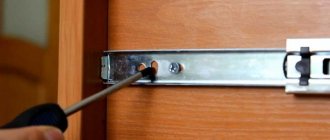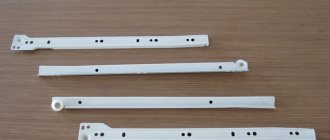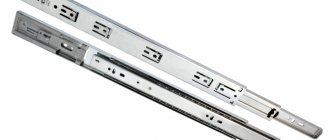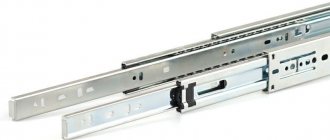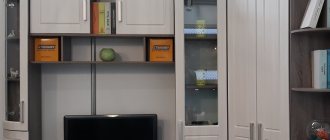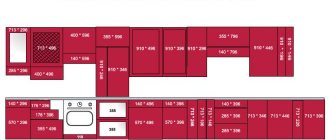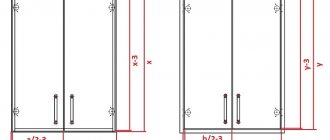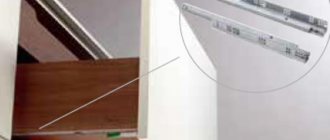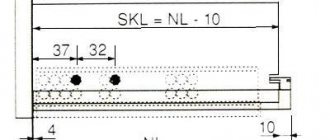Telescopic guides for drawers are modern fittings that allow you to effortlessly open even massive structures. Despite the fact that in almost any piece of furniture you can find drawers that can be pulled out due to the installation of special fittings, telescopic (or as they are also called ball) guides have gained great popularity only in recent years.
Today we will take a detailed look at their features and types, talk about how such fittings work, what advantages and disadvantages they have. We will also tell you step-by-step about the installation of telescopic drawer systems and simple repair of the guides, which you can do yourself.
Telescopic guides for drawers
Features of telescopic systems
Ball guides have a fairly simple design; their mechanism consists of main and auxiliary parts - these are metal runners and balls, as well as stopper elements and other limiters, which can be metal or plastic.
Telescopic guides are technologically advanced, durable fittings
This system greatly simplifies the operation process.
In order to understand the mechanism of their operation, we will consider the simplest version of two-section non-demountable telescopes. In this case, there are two rails that differ in size and are U-shaped, so that one part can fit into the other.
The mechanism is driven by moving metal tracks
There are small balls in the upper or lower part (between the parts), and the stopper is represented by the protruding edge of the rail. So in a certain area its movement stops.
The system received this name due to the fact that one track is placed inside another and extends like a telescope.
What types of ball guides are there?
Depending on the purpose, telescopic guides are distinguished by shape and other functions. Basically, they are divided according to the following characteristics:
- collapsible and non-dismountable mechanisms;
- two-section or multi-section (number of steps);
- multi-level or single-level.
The fittings have various mounting options
Telescopes can be installed both on the sidewalls and in grooves.
The difference between non-separable mechanisms is that they are quite low in cost compared to analogues. This difference is due to some difficulties in the production of collapsible rails and a specific method of fixing the balls, because the structure must be designed in such a way that the guide can be disassembled without losing small elements.
Easy movement of boxes made of any materials is ensured by special balls
Of course, the cost is also influenced by the number of stages of the mechanism. This is also due to the peculiarities of the production of more complex parts.
Guides for this type of drawer come in a variety of colors, including black, steel, and zinc yellow. Balls are made of steel and nylon. It is worth noting that plastic balls are the quietest.
In most cases, drawers in cabinets with sliding doors are installed on telescopic guides
Drawer guides: features
The most popular are roller products. They are most often used in the production of modern interior elements. There is a constant demand for them due to trouble-free operation and ease of operation. The base is steel or aluminum fasteners, a set of rollers, the movement of which in the groove occurs inertia after a jerk or push performed by the user. The outer layer is rubber. The devices are easy to install. Indispensable for cabinet furniture.
Ball elements are also in demand. Important advantages: absence of noise during operation, possibility of installation on a plane, below/above the retractable structure. Stability is guaranteed due to the fact that the load during extension is distributed evenly. The boxes extend completely, providing complete comfort during use. If cabinets are intended to store heavy items, we recommend ball fittings, which are durable and have a long service life.
Hidden - they are attached under the bottom of the module, which is why the effect of floating and weightlessness is achieved. Reliability is ensured by built-in dampers that guarantee soft, silent extension. Scope of application: furniture made of natural wood, chipboard and other materials.
Advantages and disadvantages of ball guides
Any mechanism has certain advantages and disadvantages. Such features should be taken into account before choosing one or another fitting for installation.
Table 1. Pros and cons of installing ball guides
| Advantages | Flaws |
|
|
Telescope mechanism suitable for massive iron boxes
The role of ball guides in furniture production
Despite the fact that ball guides are used in various industries, such fittings are most popular in furniture manufacturing.
Most often they are installed in various wardrobe systems, chests of drawers, cabinets. This means that they can be found in any type of furniture that is designed for comfort and space saving. It is worth noting that the presence of such a system greatly simplifies the use of sliding cabinets.
A bed with drawers mounted on telescopic fittings
Ball guides
A more expensive, but also much more preferable type of furniture fittings for the modern user, in terms of practical characteristics. The basic version of ball guides for drawers (without additional functions) is a set of left and right sliding mechanisms, each of which includes two continuous plates (one inserted into the other) and a third mounted on the inner surface of the side wall of the module. The rollers, like the rails, are made of metal. In general, installing ball guides for drawers is similar to installing roller guides, but requires more careful marking, according to the additive diagram, and additional adjustments in place.
Full extension ball guides have a number of modifications that are used depending on the wishes of customers to furniture manufacturers.
- With closer. The design includes a soft-closing mechanism, that is, when the drawer is closed, the guides gently and silently roll it to the closed state. Ball-type drawer guides with a closer can also be hidden-mounted mechanisms.
- With ejector. This opening system is also known as Push to open and involves the absence of a handle on the facade. That is, you pull out and close the drawer by pressing its front panel. A box for ball guides of this type can also be a hidden installation system, including one with a closer.
It is also worth noting that ball guides are also available in a partial extension version, similar to standard roller guides.
Installation of telescopic guides
We will consider the option of mounting telescopes using the example of the lower part of a kitchen table with drawers.
Calculations
At the very beginning, we need to determine the length and types of guides that will be used during further installation.
The basis will be a table of standard dimensions: length 520 millimeters and height 720 millimeters
The first type is a two-row incomplete extension design, and in our case such a mechanism will not work. The second type is the four row full extension slides which are perfect for this desk.
Next, you will need to determine the length of the sidewall, in this case it is equal to 520 millimeters, the type of back wall of the invoice. Even if the design assumes the presence of an inset wall, a 500 mm guide will still fit. Therefore, in any case, it will be optimal to choose exactly this length, but the method of fixing the back wall must be taken into account.
All calculations must be carried out starting from the facades
In this case, we will have 3 facades of 140 millimeters each and 1 facade of 292 millimeters. Calculating the length of the facades is quite simple. You just need to know the height of the case, which in this case is 720 millimeters.
This can be calculated using the following example, in the end we got 712 millimeters, which we divided into four facades
It should be borne in mind that each manufacturer has its own standard range of parts and most often the changes relate specifically to the height of the facades.
In order to correctly place the markings on the sides of the structure, it is necessary to consider the location of the drawers
Now you need to figure out how to calculate these dimensions. In this case, it is necessary to take into account the value of the lower indentation, which is 17 millimeters. So, the distance from the floor to the first box will be 25 millimeters, now you should add the height of half of this box, in this case it is 50 millimeters. The result was 75 millimeters.
The next size can be obtained taking into account the height of the lower facade. Here you should add 2 millimeters for the gap and another half from the other box. This is based on the fact that the boxes are 100 millimeters high and are located in the central part of the narrow facades, which are 140 millimeters high. Thus, 140 should be divided by 2 - it turns out 70 millimeters, which we add.
The next two calculations can be obtained by adding the previous ones
This means that 142 millimeters will need to be added to the dimensions that we have already received. Most often, the guides are installed before assembling the case itself, so you can simply subtract 16 millimeters from previous calculations or determine the values along the entire chain.
Next we will look at how to calculate the width of the drawers. In this case, our table length is 600 millimeters. Since in most cases laminated chipboard or MDF measuring 16 millimeters is used in furniture production, we will need to subtract 32 millimeters from the total width of the structure.
Determining the width of the drawers
In addition, from the resulting value of 568 millimeters, you will need to subtract another 26 millimeters for gaps.
Video - Installation of telescopic guides: calculations
Installation
Upon completion of all preliminary calculations, you can now move on to the practical part - installing telescopic guides.
The next two calculations can be obtained by adding the previous ones
Example of fixation on fiberboard
It is important to note one more digression - if you use guides on rollers, then the fiberboard bottom can be fixed to furniture nails. In the case of ball guides, it is recommended to use self-tapping screws as fasteners; in this case, you can also make an inset bottom.
Step-by-step instruction
Step one: the first thing we need to do is detach the inner part and attach it to the axle that divides our box into two parts. The guide has many holes for adjustment. In this case, we will start with longitudinal adjustment.
Attach the guide to the marking
Step two: you need to make a longitudinal adjustment so that the edge of the guide on the front is flush with the front edge of the side panel. After which you can already adjust the height.
Adjusting the location of the guide
Step three: after the work has been done, you need to begin installing the main part of the guide to the side of the table. Essentially, the mounting principle is the same, but in most cases there is no way to adjust the height. That is why when purchasing guides it is necessary to take this principle into account, because mechanisms with additional adjustment have a higher cost. Budget options were used here.
Installation of the main guide
Step four: the last step is to secure the drawers in place and check their functionality. You can insert all four drawers at once or one at a time.
Putting the boxes in place
Step five: the last step is to secure the facades. This should be done using double-sided adhesive tape and self-tapping screws (as shown in the image).
We install facades
There should be a gap of two millimeters between the facades. In order to make it, you should take a PVC edge tape of this diameter or any other object of the same width.
Retractable mechanisms for drawers, types and subtypes
Wooden and plastic “sleds” are already a thing of the past. Some difficulties are experienced by those who decide to restore or repair an old chest of drawers or sideboard with their own hands. It will be extremely difficult for them to select any drawer system for drawers on such runners, without adjusting the necessary gaps to be able to install modern mechanisms.
It’s better to leave everything as is, clean and re-glue the broken parts of the chest of drawers. All other methods will be associated with labor-intensive and financially expensive alterations of both the drawers themselves and the inside of the furniture with your own hands - as a rule, in such furnishings it is not monolithic, but assembled on the basis of a frame.
With the help of linings, the attachment points of the selected guides are “formed”. And then, after measuring the resulting openings for installing the drawer, new boxes of drawers are ordered in size. That is, in fact, after such a repair, only the front part of the old chest of drawers remains. And inside he moves completely.
The main types of modern retractable mechanisms for drawers
In order of increasing cost and quality of guides, all offered sliding mechanisms for drawers can be divided into two main types and four varieties:
- Roller and ball guides.
- Metaboxes and tandemboxes.
Visually distinguishing them is not difficult. To install the first two, you need a separate box box, with all the sides made of laminated chipboard and the bottom made of fiberboard. The sides of the second type of drawers, metaboxes and tandemboxes, are metal; they are actually part of the retractable system.
To install such retractable systems with metal sides, it is necessary to “assemble” the drawer box from the back wall and the bottom from laminated chipboard. The dimensions of the parts are calculated according to the formulas of the specific selected system.
We will consider the remaining fundamental differences separately.
Roller and ball guides, comparison
The “evolution” of wooden and plastic runners began with the simplest roller mechanisms and came to ball retraction systems.
The advantages of roller guides for drawers include relatively low cost, easy movement, ease of removing the drawer from the body, and easy installation with your own hands according to the marking diagram.
True, the markings should be done as accurately as possible, down to the millimeter, since the ability to adjust the drawer stroke and install the facade is very limited.
Also among the disadvantages should be noted the fragility of the roller guides and noisy operation. The wheels, thanks to which the box moves along the slides, although “wrapped” in a rubberized shell, do not ensure silent movement. When the box is heavily loaded or there is any distortion in the box, they begin to creak and fall out of the grooves.
Ball guides for drawers are silent and can withstand much larger loads. And much more durable.
In addition, the range of ball guides is much more diverse: they can be full or partial extension, with different load-bearing capacities, equipped with closers, etc. But they also cost more than roller ones.
Retractable metabox system
Metaboxes (metalboxes) are a retractable mechanism with single-walled drawer sides and guides on rollers. From the point of view of “evolution”, metaboxes can be called a “branch” of the development of roller guides.
The range of metaboxes allows you to choose between full and partial extension drawers, with a load capacity of up to 25-30 kg, with soft-closing closers and the ability to expand the side walls using special elements - rails and perforated walls.
Rails can be attached both along the drawer guides and across them using special fasteners. They form an additional system of divisions for fixed storage of any items inside the box.
Such accessories are not suitable for all metaboxes! Consider the series of specific manufacturers and the range of accessories offered for the series. The photo shows the metabox blum series. It also has the ability to install closers, various blockers and locks.
Bloom metabox extension systems are characterized by minimal sagging, high stability and excellent gliding throughout their entire service life.
The size range of metal boxes allows you to choose length guides for boxes with a depth of 250-750 mm from different manufacturers. And the height of the side is 54, 86, 118 or 150 mm (with the possibility of extension with additional elements).
Retractable tandembox system
Tandemboxes are a “collective” term for all double-walled extension systems, inside of which a more advanced ball mechanism with an additional “upgrade” is hidden, providing greater load capacity and smoother operation.
Each manufacturer has its own series of “tandem boxes” with double metal sides of the boxes. For example, Tandembox from Blum, Innotech from Hettich, Swimbox from Boyard, Delinia from Leroy Merlin.
Each series has certain quality characteristics and the ability to expand functionality with various elements in the form of inserts, dividers and roof rails.
Additional design of the drawer can expand not only the functionality of storage, but also be one of the components of the interior design.
Repair of roller guides
Despite the fact that telescopic guides are considered the most durable compared to other options, in some cases failures occur. Of course, under such circumstances, you can replace the fittings, but it is still worth trying to repair it.
In this case, we will look at repairs using the example of full extension ball guides. The breakdown is that the plastic retainer has become unusable. It allows you to hold the box, thereby preventing it from jumping out of the rail.
Plastic retainer
Thin plastic can break during use, as happened in our case.
Of course, such a breakdown does not have any effect on the operation of the guide itself, but the box will not be fixed properly. Therefore, if you push it all the way, it will simply fly out. This, in turn, is unsafe because massive boxes can fall on your feet. That is why, if there is no stopper, they should not be pulled out.
Video - How to remove a drawer with ball guides
Telescopic guide repair instructions
Step one: you need to take a wire with a diameter of 2 millimeters. In this case, strong stainless steel wire is used, but you can use another one. At the same time, it should spring a little. In total, we will need to cut 9 centimeters from it (maybe a little longer or shorter) - this is the standard length of the clamp in any type of guide. The mechanism used here is 50 centimeters long, but it can be shorter.
Wire with a diameter of 2 millimeters
Step two: stepping back 1 centimeter, you need to make a bend at the end of the wire. Next, use a tape measure to measure another 2 centimeters from this bend and make another one.
The result should be something like this, which will now need to be bent in the opposite direction
Step three: now you should step back from the edge about 5 millimeters and bend it in the other direction. First, we get a small bevel, which will not be enough for a stopper, so we take another pliers. Next, we use two pliers to make the maximum bend.
Now we have a more durable clamp
Step four: you need to step back another 3 centimeters from this bend, and make another bend in the wire. The main thing is that all bends should be exclusively in the same plane, otherwise you will end up with a crooked latch that will not work properly.
Let's make a bend like this
Now, using pliers, you need to make such an eye at the end
Now you need to hammer in the latch using the same tool
At this stage our fixative is ready. Compared to a plastic product, it will last for many years, and besides, it is quite easy to make it at home. If desired, you can prepare a wire of 10 centimeters - a long clamp will work more smoothly.
Roller guides
An option for budget furniture, when extended functionality is not required from the guides (full extension, closer, ejector, etc.), but reliable operation for its intended purpose is required - the movement of the drawer, its easy removal from the furniture frame and retraction. Roller guides for drawers, each included (left and right), are two metal plates that move relative to each other using plastic rollers.
Installation of roller guides (on each side) is as follows:
- One plate is mounted on the body of the furniture module, actually serving as a support rail along which the box will move.
- The second plate is attached as a corner to the side wall and bottom of the box.
- Next, the box is inserted into the module so that the plates are interlocked, and is pulled out/retracted due to the movement of the rollers along the guides.
Thus, guided by the additive diagram supplied with the set of guides or presented in the manufacturer’s electronic catalog, almost any home craftsman will be able to figure out how to assemble roller guides.
Simple installation is one of the main, but not the only useful features of retractable mechanisms of this type. Provided the drawer is loaded with lightweight items, the roller guides guarantee a long service life and minimal effort when pulling the drawer out and in. But if you intend to store heavy contents, and you also need full extension of the drawer and additional operational properties (self-closing, Push to open, etc.), then it is necessary to replace the roller guides with ball ones, at the stage of furniture design or already on the finished product.
Roller guides: what are their features?
In order to understand why many furniture makers choose telescopic guides, it is necessary to familiarize yourself with the structure of roller fittings.
Such mechanisms became available to a wide mass of buyers back in the 90s, when the first imported accessories began to be sold. In most cases, the products were manufactured in China, so they were not always of ideal quality, but there were exceptions.
Just a couple of decades ago, such mechanisms were considered very popular. They were used for furniture of any type, including cabinets, chests of drawers, and computer desks.
They are in the form of two planks, one of which is fixed to the wall of the structure, and the other to the box itself. The connection between them is represented by plastic rollers, thanks to which movement occurs.
Roller mechanism
The following positive aspects of installing roller guides can be noted:
- they are also distinguished by good strength;
- it is not difficult to repair such a structure yourself;
- they can be installed without the help of a professional technician;
- Guides of this type are characterized by a low price.
Roller guides are still included in budget furniture today
. In addition, the following negative aspects of installing such accessories are noted:
- it is impossible to pull out the drawers to the very end, because there must be some space left to connect the two parts of the guides;
- If installed incorrectly, there is a high probability of rapid breakdown of the mechanism;
- such fittings will not be able to support a box that is too massive, because the plastic rollers will simply break due to such pressure;
- plastic rollers wear out after a while - this leads to the fact that the drawers begin to constantly jam;
- less aesthetic appearance compared to telescopes.
Roller guides
How to choose the right guides?
When choosing guides for your furniture, you should pay attention to a number of factors. Due to them, the design ensures silent and smooth opening/closing of the drawer, which can be installed in a wide variety of furniture. When choosing guide structures, pay attention to the following recommendations:
- Installation will be significantly more complicated if the dimensions of the guides do not match the dimensions of the furniture.
- When purchasing guides, pay attention to the thickness of the metal structure (at least 1 - 1.2 mm).
- The appearance of the part must be perfect, without scratches or deformations.
- Make sure that all necessary accessories are included in the kit.
- When choosing tandem boxes, make sure that you can handle the installation yourself. This is a specific design that is installed by specialists.
The choice of guides should be taken seriously, since not only the service life of furniture elements, but also safety and ease of use will depend on your choice. Take our advice into account and choose quality items.
What other retractable mechanisms are there?
There are other drawer systems:
- Metaboxes. This is the name of the retractable mechanism, which is based on roller guides. The system assumes only partial extension to three-quarters of the entire length. Such a box should carry a load of no more than 20 kilograms.
- Tandems. The mechanism is an open type guide. The system provides partial extension and smooth operation. The advantage is that the box will be easy to dismantle without specialized tools.
- Tandemboxes. These are the most expensive guides. The kit contains components for installing fittings to the facade and rear wall. Such a system sometimes involves automatic opening of the drawer - all you need to do is press the front.
Drawer on Tandembox guides
General criteria for choosing guides and drawer mechanisms for drawers
All systems of retractable guides for cabinet furniture are support rails with symmetrical fastening to the inner sides of the cabinet sides. Their main function is to ensure the movement of retractable furniture elements (drawers, shelves, baskets, etc.).
Load bearing capacity
The first criterion for choosing drawer guides is load capacity. Thanks to the high-tech developments of individual furniture market leaders, modern drawer mechanisms can withstand loads of up to 60-70 kg. However, for a simple chest of drawers for storing clothes, shoes and other wardrobe items, such a carrying capacity is not needed; you can limit yourself to a choice of 10-20 kg. For large lower kitchen drawers, pull-out systems with a load-bearing capacity of 30-50 kg are usually selected; they can store heavy pots, pans and other kitchen utensils.
Extension system: full and partial extension, hidden installation
The second selection criterion is the type of drawer system.
There are full extension and partial extension drawers (approximately 70-80% of the cabinet body). The former are, of course, much more convenient, but also cost several times more. Such an investment is justified if you plan to store something large in the drawer that does not change its volume. For example, square containers for bulk products, tall pots or household appliances in boxes. For linen and “office” drawers, the use of full drawer systems is not important.
Separately, it is worth highlighting systems for sliding drawers of hidden installation, when the sliding mechanism is installed in the bottom area, and not on the sides of the drawer.
For the most part, they are not of any practical nature, there are only visual differences - a box with “smooth” sides, without guides, looks more aesthetically pleasing. As a rule, retractable mechanisms for hidden-mounted drawers are designed for a large load capacity, which is understandable due to the nuances of installation.
Guide length
To maximize the use of a cabinet or cabinet for storage, drawer guides should be selected according to the depth of the sidewalls. Most manufacturers offer retractable systems in 50mm increments, ranging from 250mm to 500, 550 or 600mm. It is very rare to find guide lengths of 650, 700 or 750 mm on sale.
For example, in a cabinet with a side depth of 400 mm, a drawer with a guide length of 350 mm is designed.
And, conversely, if you plan to install drawers, baskets or cargo with a depth of 500mm in a kitchen cabinet, you should design a box for “them” with a depth of 520-550mm.
About the width of drawers
From the point of view of ergonomics and ease of use, the optimal width of a drawer is about 400-900mm. If you want to make a longer drawer, for example, in the design of an elongated TV stand, then you should immediately discuss the nuances of its operation. It should be loaded with things evenly, otherwise it will inevitably warp. And the guides will quickly fail.
By the way, the TIP-ON retractable system, which opens the drawer when pressed, has a synchronizer that ensures uniform opening. It is designed specifically for long-width drawers.
“Push” mechanism for drawing out the drawer: opening by pressing
Blum's aforementioned Tip-on pull-out mechanism offers push-to-open operation for handle-less cabinet designs.
Hettich has a similar opening and sliding system called Push to Open. You can read about other possibilities for opening drawers using a push mechanism in the article “Pushers for facades.”
This category also includes opening systems operating on an electric drive. True, you will need to press not the facade, but the electric drive button.
Pull-out mechanisms for drawers with closers
The presence of a damping system on the facades and drawers of the kitchen, children's room, and any other cabinet furniture significantly increases the service life of the opening and closing mechanisms. Not to mention a qualitatively different level of comfort during use - “silent” furniture is much more pleasant to use.
In most tandem boxes, a soft closing mechanism, “pulling” the box into the closed state, is built in by default. When choosing one option or another, pay attention to the presence of this characteristic.
The closer can be built into the ball guides right away, as you can see in the photo.
But the design of the roller guides does not allow the possibility of integrating a soft closing mechanism. For metaboxes, you can purchase a closer capsule separately; you can read about how to select and install closers on a drawer here.
I also recommend reading about the principles of fastening the drawer drawer mechanism, the installation method using the example of installing ball guides. Perhaps this information will be useful to you when choosing a particular type of guides or pull-out mechanism for drawers.
Let's sum it up
You should choose one or another type of retractable fittings based on the design features of the furniture and your personal preferences. At the same time, if you want to get a durable mechanism, then you should not save money on its purchase, because low-quality guides quickly jam and stop functioning. The best option today is a telescopic system, and the installation of such fittings can be done without the help of a specialist - you just need to have all the necessary tools and fasteners on hand.

